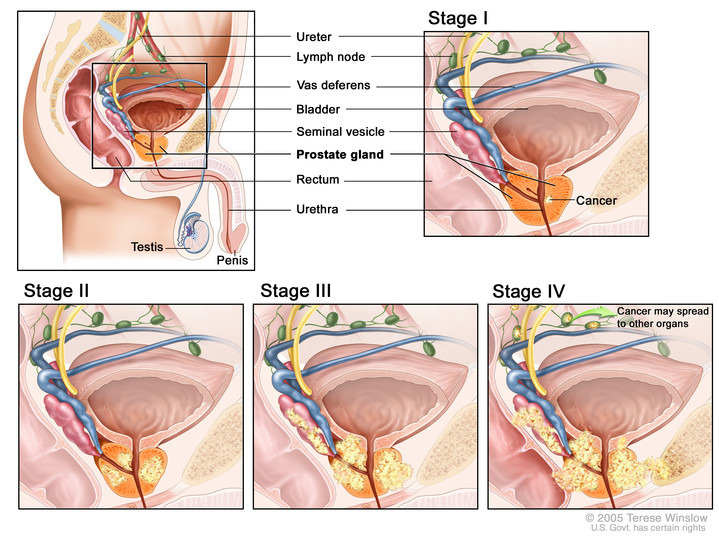Table of Contents
Prostate cancer is one of the most common cancers in men. In fact, it is the second leading cause of cancer death in American men, after lung cancer. However, prostate cancer is often a slow-growing cancer, and many men with prostate cancer may never experience any symptoms or require treatment.

This is a type of cancer that develops in the prostate gland, which is a small, walnut-shaped gland located below the bladder and in front of the rectum in men. The prostate gland produces a fluid that nourishes and protects sperm.
Cause of Prostate cancer
The exact cause is not fully known, but researchers have identified several risk factors that can increase a man’s chances of developing the disease. Here are 10 of them:
- Age: Prostate cancer is most common in older men. The risk increases significantly after age 50.
- Family history: Having a father or brother with prostate cancer increases a man’s risk. The risk is even higher if more than one close relative has the disease.
- African American race: African American men are more likely to develop prostate cancer and die from the disease than men of other races.
- Obesity: Being overweight or obese increases the risk of developing more aggressive prostate cancer.
- Diet: A diet high in red meat and processed meats may increase the risk of prostate cancer.
- High-calcium diet: Some studies suggest that a diet high in calcium may increase the risk of prostate cancer.
- Inactivity: Men who are not physically active may have a higher risk of developing prostate cancer.
- Exposure to certain chemicals: Exposure to certain chemicals, such as herbicides and agents used in some manufacturing processes, may increase the risk of prostate cancer.
- Inflammation: Chronic inflammation may play a role in the development of prostate cancer.
- Family history of BRCA1 or BRCA2 gene mutations: Men who inherit mutations in these genes, which are also linked to breast and ovarian cancer, have an increased risk of developing prostate cancer.
It’s important to note that having a risk factor does not mean that a man will definitely develop prostate cancer. Conversely, some men with no risk factors may still develop the disease.
Signs and Symptoms
Early-stage prostate cancer typically doesn’t cause any symptoms. In many cases, the initial signs of prostate cancer are often confused with symptoms of a benign condition called benign prostatic hyperplasia (BPH), which is an enlargement of the prostate gland.
Here are some signs and symptoms that may occur with prostate cancer:
- Urinary problems: These are the most common symptoms of prostate cancer. They can include:
- Frequent urination, especially at night (nocturia)
- Difficulty starting urination (hesitancy)
- Weak or interrupted flow of urine
- Urgent need to urinate (urgency)
- Feeling that the bladder has not emptied completely (post-micturition dribbling)
- Blood in the urine or semen
- Pain or burning during urination (dysuria) – less common
- Erectile dysfunction (ED)
- Pain in the lower back, hips, or thighs – can be a sign that cancer has spread to the bones
- Unexplained weight loss
- Swelling or tenderness in the legs or feet
If you are experiencing any of these symptoms, it is important to see a doctor to determine the cause. These symptoms can be caused by other conditions besides prostate cancer, but it is important to get a diagnosis so that you can receive appropriate treatment.
Survival rate
The survival rate for prostate cancer varies depending on several factors, including the stage and grade of the cancer at diagnosis, a man’s age and overall health, and how well the treatment works.
Here’s a breakdown of some general survival rates:
- The 5-year relative survival rate for prostate cancer in the United States is around 97%. This means that men diagnosed with prostate cancer are, on average, about 97% as likely as men without cancer to live for at least 5 years after diagnosis.
- The 10-year relative survival rate is around 98%.
However, it’s important to understand that these are just statistics and don’t apply to every individual case. Here are some additional points to consider:
- Survival rates are significantly higher for early-stage. For men with prostate cancer confined only to the prostate, the 5-year relative survival rate is nearly 100%.
- Advanced-stage (cancer that has spread beyond the prostate) has a lower survival rate. The 5-year relative survival rate for distant-stage prostate cancer is around 32%.
- Age and overall health also play a role. Younger men and men with better overall health tend to have a better prognosis.
- Treatment success can significantly impact survival rates.
If you’re concerned about prostate cancer, it’s important to talk to your doctor about your individual risk factors and screening options. Early detection and treatment can significantly improve the chances of a successful outcome.
Stages of Prostate Cancer
Doctors use the TNM staging system to classify this cancer. This system considers three main factors:
- T (Tumor): The extent of the primary tumor (the original tumor)
- N (Node): Whether the cancer has spread to nearby lymph nodes
- M (Metastasis): Whether the cancer has spread (metastasized) to other parts of the body
It can also be classified by grade, which indicates how aggressive the cancer cells are and how likely they are to spread. The Gleason score is a common grading system used for this cancer.
Here’s a breakdown of the stages of prostate cancer based on the TNM system:
Stage I:
- Early-stage cancer
- The cancer is confined to the prostate and is usually too small to be felt during a digital rectal exam (DRE)
- PSA level is typically low
- There are two categories within Stage I:
- Stage IA: The cancer is only found in a small needle biopsy sample and is unlikely to spread

Stage II:
- The cancer is still confined to the prostate but may be slightly larger than stage I cancer
- PSA level may be higher than in stage I
Stage III:
- The cancer has grown outside the prostate gland but has not spread to the lymph nodes
- The cancer may have spread to the seminal vesicles, which are two small glands that sit behind the prostate and produce seminal fluid
Stage IV:
- The cancer has spread to other parts of the body, such as the lymph nodes or bones
- This is the most advanced stage of prostate cancer.
Here are some additional points to consider about this cancer staging
- The stage of prostate cancer is an important factor in determining treatment options and prognosis.
- Not all cancers within the same stage are created equal. Some stage II or III cancers may be very aggressive, while some stage IV cancers may grow very slowly.
- Newer tests and imaging techniques are constantly improving our ability to diagnose and stage prostate cancer.
For More detalis Please visit the link: https://www.cancer.gov/publications/dictionaries/cancer-terms/def/stage-iii-prostate-cancer
What is the longest someone has lived with stage 4 this cancer?
It’s difficult to say definitively what the absolute longest someone has lived with stage 4 prostate cancer. This is because medical data on individual cases isn’t always publicly available, and factors affecting survival can vary greatly.
However, here’s what we do know:
- Survival rates for stage 4 prostate cancer are lower than for earlier stages. The 5-year relative survival rate is around 32%. But, this statistic is just an average.
- Some men with stage 4 prostate cancer can live for many years with successful treatment and depending on their overall health. Advancements in medicine and personalized therapy approaches can significantly impact outcomes.
- Doctors typically focus on managing the cancer and controlling its spread rather than achieving a complete cure in stage 4 cases.
If you’re looking for more information on survival rates and treatment options, talking to a doctor is the best course of action. They can consider your individual circumstances and provide the most accurate picture for your specific situation.
Go through the related notes:
- Cell cycle checkpoints: https://thebiologyislove.com/cell-cycle-checkpoints/
- Useful Numbers for cell culture: https://thebiologyislove.com/useful-numbers-for-cell-culture/

